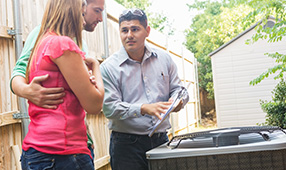Summer break is right around the corner! But before you break out your swimsuit or fire up the grill, you need to make sure your home and garden are ready for the new season.
On a warm late-winter day, make a thorough inspection of your home and landscape, advises Joene Hendry, a Connecticut-based garden designer, organic land care professional and garden writer-blogger. “Fix all hazards before someone gets hurt,” she cautions, or before your property incurs any damage.
Master gardener Jodi Torpey agrees. “Most people jump in without taking a clear-eyed inventory of what needs to be done and then prioritizing the tasks,” says Torpey, founder and editor-in-chief of WesternGardeners.com.
The following to-do checklists can help you focus on prepping your home and yard for warm weather.
HOME CHECKLIST
Inspect for and fix existing damage and problem spots
Look for unstable retaining walls, loose railings, leaky gutters, warped or broken deck boards and loose or unsafe steps and stairs.
Keep an eye out for spots where soil settling is causing rainwater to collect instead of draining away.
Use binoculars (instead of climbing a ladder) to check your roof for cracked, damaged or missing shingles. Look for white water stains on brick or stone, which can signal that the chimney needs to be resealed. If there’s rust around the chimney, it means water is getting into the chimney and on the metal flashing. Find the source and fix the problem before it gets worse.
Repair any gaps, cracks or holes in the brick, stone or mortar.
Binoculars also are handy for checking the condition of eaves, gutters and downspouts.
Poke around in your attic and garage
Check for signs of leaks such as water stains, mold, rotting boards and color changes in the insulation.
If you find evidence that critters such as birds, squirrels or raccoons have found a way in, seal off their entryways and call in a professional to help make sure the invaders don’t return.
Get a jump on termites
Each year, ravenous termites attack thousands of homes and cause billions of dollars in damage as they feast on wood in houses. They also can harm insulation, books, paper and even nearby trees. The problem is so bad that homebuyers and sellers routinely require a termite inspection as a condition of sale.
You’ll need an experienced, knowledgeable professional to get rid of them. Treatment with a liquid termiticide (termite killer) is supposed to last 5 years. Actual duration may vary, depending on how the treatment was applied, presence of termites in the area and other factors.
Clean out your gutters
Damage caused by clogged gutters and slow-draining downspouts can be difficult and costly to fix. Before heavy rains arrive, hire a professional to clean out debris. Plan to look for signs of damage once or twice a year, depending on local conditions such as climate and how many trees are close to your house.
Clean your air
Clean or replace filters in your heating and air conditioning system each month, advises the Fair Housing Clinic of Howard University School of Law in Washington, D.C. Once every 2 to 3 years, you should have your air conditioning system checked and serviced by a professional.
GARDEN CHECKLIST
Inspect for and fix existing damage and problem spots
First, thoroughly inspect your landscape for any damages—such as broken tree limbs—that could injure a person or your home, and fix those issues right away.
Then, turn to the maintenance of your trees. “Trees are the biggest investment in the landscape, so taking care of them should be first on the list,” Torpey says. “If pruning dead wood and broken branches sounds like more than you can handle, call a certified arborist early in the season.”
Check the hardscaping such as stepping stones, walks and rock walls for cracks.
Thin out old and overgrown shrubs now to encourage new growth, but leave flowering shrubs (such as lilacs) alone until after they’ve finished blooming.
Trim back perennials, clip ornamental grasses and look for bare spots that need to be replanted or remulched, Torpey says.
If ground heaving caused by freeze-thaw cycles popped any plants out of the ground, check for damage and either replant or replace them.
Whack the weeds
Weed now and you’ll save yourself work later. Although spring is the best time to attack young weeds before their root systems are fully developed, early summer weeding will still benefit your plants. Hendry recommends using a garden knife to dig under the weed and lift the entire root mass out of the soil.
Plant early
Give your garden a head start by planting early-season flowers, vegetables, shrubs and trees that grow well in your region. Check the zone hardiness numbers on labels to be sure the plants will thrive in your area. You can do this online with the USDA’s Plant Hardiness Zone Map: Click your state, or type your ZIP code into the search box.
“Trees and shrubs top my list for planting in spring,” Torpey says. “Not only do they beautify the landscape, they add value to your property and help save on energy costs, too.” Remember to take care of these new additions during the summer as the temperatures rise with watering and proper care.
Replace garden hoses
If your garden hoses and nozzles aren’t in good condition, replace them. Buy the best quality you can afford because they’ll last longer and be easier to use, Hendry says. They’re thicker, more resistant to sun and weather and easier to coil and uncoil than those of lesser quality.
If you have an automatic sprinkler system, check pipes, faucets and other parts before watering season starts, or hire a sprinkler system contractor who can check and restart the system for you.
Tune up your tools
Check garden tools for wear, loose parts and broken handles. If they’re not worth fixing, “look for high-quality replacements that feel good in your hands and are an appropriate size and weight for your body,” Hendry says. Higher-quality tools should last longer.
Treat your grass right
Prevent crabgrass and lawn weeds by applying pre-emergent herbicides early, before seeds start to germinate, Torpey advises. Later, aerate and fertilize the lawn. Repeat the process in the fall to get your lawn ready for the following spring.
If you want to hire a lawn service to take care of these tasks, ask trusted neighbors and colleagues for recommendations. Choose a local service that’s insured and locally respected. Get a season-long contract, and remember that “the cheapest service is often not the best choice,” Hendry says.












